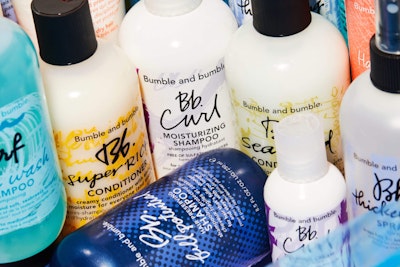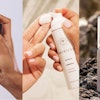Bumble and bumble
Cruelty-free hair care

Bumble and bumble's Sustainability Rating
Fair
Ingredients
Bumble and bumble has made ingredient commitments to lower its environmental impact, including by avoiding parabens, phthalates and select other petrochemical-based ingredients. However it still use many ingredients that pose a significant threat to the climate, including many petrochemical-based ingredients, microplastics, benzophenone (a harmful suncare ingredient), and uncertified mica. Bumble and bumble carries products that are PETA Animal Test-free.
Containers & Packaging
Bumble and bumble hasn't made any efforts to concentrate its products or minimize its containers, which increases shipping emissions and packaging volumes. It uses primarily plastic for its product containers and also includes some eco-friendly materials, including ones that are recyclable and reusable, and its shipping packaging includes materials that are recyclable.
Energy & Water Use
Bumble and bumble's parent company, Estee Lauder Companies, shares information on its energy strategy. It uses some renewable energy to power its production sites and 100% renewable energy to power its corporate offices. Estee Lauder Companies has targets for expanding its use of renewable energy. It implements energy efficiency measures in its production sites and corporate offices. It implements water conservation measures including initatives around wastewater recycling and engaging suppliers. Bumble and bumble has a global production span, which is standard for the industry.
Refill & Reuse
Bumble and bumble doesn't utilize any alternative models or methods to avert waste. It offers bulk sizes for some products, which may help reduce packaging waste.
Slow Cleaning
Bumble and bumble offers frequent releases, which can encourage overconsumption and production of excess inventory.
Marketing
Commons is still evaluating this brand's marketing emails.
Transparency & Reporting
Bumble and bumble has a sustainability page with limited details on its climate strategy, but this page is hard to find on its website. It's parent company, Estee Lauder Companies, publishes a detailed annual report with a clear, impact-driven strategy and progress reporting. Its last annual report was published in 2024. Bumble and bumble shares a complete list of ingredients used in its products on a per product basis but includes an ingredient glossary that only highlights certain ingredients and may be misleading to consumers.
Emissions Tracking
Bumble and bumble's parent company, Estee Lauder Compnaies, internally measures and publicly reports its company-level emissions in partnership with, or with auditing from, a third party. It includes a breakdown by scope. The last reporting period was 2024. In its most recent update, its estimated emissions footprint was 2,062,976 tons CO2e.
Targets & Offsets
Bumble and bumble's parent company, Estee Lauder Companies, has SBTi-approved emissions reduction targets for the medium-term (5-10 years). It has reported on its progress within the past year, and is on track for some of its targets. The brand offsets emissions from its corporate operations.
Supply Chain & Labor
Bumble and bumble's parent company, Estee Lauder Companies, publishes limited information about its supply chain partners. It traces some of its supply chain. It publicly shares a supplier code of conduct, which prohibits forced labor but does not disallow unauthorized subcontracting, ensure the right to collective bargaining, ensure a living wage, establish grievance mechanisms, prohibit child labor, or include environmental clauses. Estee Lauder Companies doesn't have a stated policy of regularly auditing its supply chain partners. This may increase human and environmental risks.
Advocacy
Bumble and bumble's parent company, Estee Lauder Companies, discloses all of its trade association memberships, including those that are climate-obstructive. It's a member of 2 large climate-obstructive trade associations: U.S. Chamber of Commerce, and Personal Care Products Council. It isn't a member of advocacy organizations advancing climate policy. Estee Lauder Companies employs state lobbyists with few fossil fuel aligned clients. Estee Lauder Companies didn't donate more than $100k to climate-obstructive candidates or PACs from 2018-2024.
Bumble and bumble is rated Fair because it has started to improve its products and packaging, but still has room to grow.
Bumble and bumble has committed to avoiding select ingredients that pose a threat to the climate, including parabens and phthalates. However, it uses many ingredients that pose a significant threat to the climate, including many petrochemical-based ingredients, microplastics, harmful suncare ingredients and uncertified mica. It also uses primarily plastic packaging of a virgin or partially PCR source and doesn't utilize any packaging minimization strategies, which contributes greatly to waste production and excess energy use.
Its parent company reports on its renewable energy strategy, and emissions measurement and reduction efforts. It has SBTi approved emissions reduction targets but is not on track to meet all of the targets. Its supplier and labor policies are less stringent than we'd hope for a company its size.
Bumble and bumble is owned by Estee Lauder Companies.
Our ratings are based on a scale from 1 (harmful) to 5 (best). How we rate →
https://www.bumbleandbumble.com/bb-minded?_gl=1*1p750tq*_up*MQ..*_gs*MQ..&gclid=CjwKCAjwsZPDBhBWEiwADuO6y_VRFlvvg1GY3j7ZwWs_0Ls0kG3AaeFq4jtrExyjxMwJtIlG040-3hoCmIcQAvD_BwE&gclsrc=aw.ds&gbraid=0AAAAADSEXtTvkZ-qaBZasL86RzrDxWnJI
https://media.elcompanies.com/files/e/estee-lauder-companies/universal/our-impact/si-s24/cdp-2024.pdf?_ga=2.45717220.1713907674.1742628992-1081797965.1742628992
https://media.elcompanies.com/files/e/estee-lauder-companies/universal/our-impact/si-s24/sis-2024.pdf?_ga=2.10132213.1713907674.1742628992-1081797965.1742628992
https://www.bumbleandbumble.com/shop-all-hair-products?_gl=1*17zapg4*_up*MQ..*_gs*MQ..&gclid=CjwKCAjwsZPDBhBWEiwADuO6y_VRFlvvg1GY3j7ZwWs_0Ls0kG3AaeFq4jtrExyjxMwJtIlG040-3hoCmIcQAvD_BwE&gclsrc=aw.ds&gbraid=0AAAAADSEXtTvkZ-qaBZasL86RzrDxWnJI
https://www.bumbleandbumble.com/bb-minded?_gl=1*1mdqnb4*_up*MQ..*_gs*MQ..&gclid=CjwKCAjwsZPDBhBWEiwADuO6y_VRFlvvg1GY3j7ZwWs_0Ls0kG3AaeFq4jtrExyjxMwJtIlG040-3hoCmIcQAvD_BwE&gclsrc=aw.ds&gbraid=0AAAAADSEXtTvkZ-qaBZasL86RzrDxWnJI
https://www.bumbleandbumble.com/ingredient-glossary?_gl=1*1mdqnb4*_up*MQ..*_gs*MQ..&gclid=CjwKCAjwsZPDBhBWEiwADuO6y_VRFlvvg1GY3j7ZwWs_0Ls0kG3AaeFq4jtrExyjxMwJtIlG040-3hoCmIcQAvD_BwE&gclsrc=aw.ds&gbraid=0AAAAADSEXtTvkZ-qaBZasL86RzrDxWnJI
https://www.elcompanies.com/en/our-impact/social-impact-and-sustainability-report
https://sciencebasedtargets.org/target-dashboard
https://media.elcompanies.com/files/e/estee-lauder-companies/universal/our-commitments/supplier-code-of-conduct/elc_supplier%20code%20of%20conduct.pdf
https://fminus.org/lobbyists/
https://www.fec.gov/data/browse-data/
Get Rewards
Earn for sustainable purchases
Commons rewards you for sustainable purchases from all our Top Rated brands, plus thousands of everyday purchases — from thrift stores to public transit.
Learn more about rewards ->







